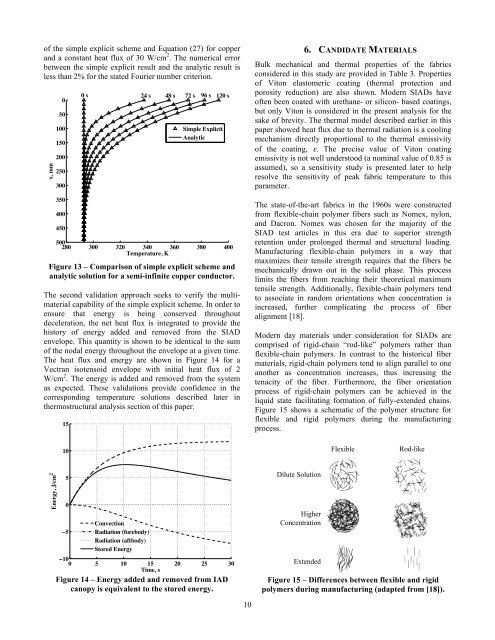Thermal, Structural, and Inflation Modeling of an Isotensoid ...
Thermal, Structural, and Inflation Modeling of an Isotensoid ...
Thermal, Structural, and Inflation Modeling of an Isotensoid ...
Create successful ePaper yourself
Turn your PDF publications into a flip-book with our unique Google optimized e-Paper software.
<strong>of</strong> the simple explicit scheme <strong><strong>an</strong>d</strong> Equation (27) for copper<br />
<strong><strong>an</strong>d</strong> a const<strong>an</strong>t heat flux <strong>of</strong> 30 W/cm 2 . The numerical error<br />
between the simple explicit result <strong><strong>an</strong>d</strong> the <strong>an</strong>alytic result is<br />
less th<strong>an</strong> 2% for the stated Fourier number criterion.<br />
x, mm<br />
0<br />
50<br />
100<br />
150<br />
200<br />
250<br />
300<br />
350<br />
400<br />
450<br />
500<br />
280 300 320 340 360 380 400<br />
Temperature, K<br />
Figure 13 – Comparison <strong>of</strong> simple explicit scheme <strong><strong>an</strong>d</strong><br />
<strong>an</strong>alytic solution for a semi-infinite copper conductor.<br />
The second validation approach seeks to verify the multimaterial<br />
capability <strong>of</strong> the simple explicit scheme. In order to<br />
ensure that energy is being conserved throughout<br />
deceleration, the net heat flux is integrated to provide the<br />
history <strong>of</strong> energy added <strong><strong>an</strong>d</strong> removed from the SIAD<br />
envelope. This qu<strong>an</strong>tity is shown to be identical to the sum<br />
<strong>of</strong> the nodal energy throughout the envelope at a given time.<br />
The heat flux <strong><strong>an</strong>d</strong> energy are shown in Figure 14 for a<br />
Vectr<strong>an</strong> isotensoid envelope with initial heat flux <strong>of</strong> 2<br />
W/cm 2 . The energy is added <strong><strong>an</strong>d</strong> removed from the system<br />
as expected. These validations provide confidence in the<br />
corresponding temperature solutions described later in<br />
thermostructural <strong>an</strong>alysis section <strong>of</strong> this paper.<br />
15<br />
0 s 24 s 48 s 72 s 96 s 120 s<br />
Simple Explicit<br />
Analytic<br />
6. CANDIDATE MATERIALS<br />
Bulk mech<strong>an</strong>ical <strong><strong>an</strong>d</strong> thermal properties <strong>of</strong> the fabrics<br />
considered in this study are provided in Table 3. Properties<br />
<strong>of</strong> Viton elastomeric coating (thermal protection <strong><strong>an</strong>d</strong><br />
porosity reduction) are also shown. Modern SIADs have<br />
<strong>of</strong>ten been coated with ureth<strong>an</strong>e- or silicon- based coatings,<br />
but only Viton is considered in the present <strong>an</strong>alysis for the<br />
sake <strong>of</strong> brevity. The thermal model described earlier in this<br />
paper showed heat flux due to thermal radiation is a cooling<br />
mech<strong>an</strong>ism directly proportional to the thermal emissivity<br />
<strong>of</strong> the coating, ε. The precise value <strong>of</strong> Viton coating<br />
emissivity is not well understood (a nominal value <strong>of</strong> 0.85 is<br />
assumed), so a sensitivity study is presented later to help<br />
resolve the sensitivity <strong>of</strong> peak fabric temperature to this<br />
parameter.<br />
The state-<strong>of</strong>-the-art fabrics in the 1960s were constructed<br />
from flexible-chain polymer fibers such as Nomex, nylon,<br />
<strong><strong>an</strong>d</strong> Dacron. Nomex was chosen for the majority <strong>of</strong> the<br />
SIAD test articles in this era due to superior strength<br />
retention under prolonged thermal <strong><strong>an</strong>d</strong> structural loading.<br />
M<strong>an</strong>ufacturing flexible-chain polymers in a way that<br />
maximizes their tensile strength requires that the fibers be<br />
mech<strong>an</strong>ically drawn out in the solid phase. This process<br />
limits the fibers from reaching their theoretical maximum<br />
tensile strength. Additionally, flexible-chain polymers tend<br />
to associate in r<strong><strong>an</strong>d</strong>om orientations when concentration is<br />
increased, further complicating the process <strong>of</strong> fiber<br />
alignment [18].<br />
Modern day materials under consideration for SIADs are<br />
comprised <strong>of</strong> rigid-chain “rod-like” polymers rather th<strong>an</strong><br />
flexible-chain polymers. In contrast to the historical fiber<br />
materials, rigid-chain polymers tend to align parallel to one<br />
<strong>an</strong>other as concentration increases, thus increasing the<br />
tenacity <strong>of</strong> the fiber. Furthermore, the fiber orientation<br />
process <strong>of</strong> rigid-chain polymers c<strong>an</strong> be achieved in the<br />
liquid state facilitating formation <strong>of</strong> fully-extended chains.<br />
Figure 15 shows a schematic <strong>of</strong> the polymer structure for<br />
flexible <strong><strong>an</strong>d</strong> rigid polymers during the m<strong>an</strong>ufacturing<br />
process.<br />
10<br />
Flexible<br />
Rod-like<br />
Energy, J/cm 2<br />
5<br />
0<br />
!5<br />
Convection<br />
Radiation (forebody)<br />
Radiation (aftbody)<br />
Stored Energy<br />
!10<br />
0 5 10 15 20 25 30<br />
Time, s<br />
Figure 14 – Energy added <strong><strong>an</strong>d</strong> removed from IAD<br />
c<strong>an</strong>opy is equivalent to the stored energy.<br />
Dilute Solution<br />
Higher<br />
Concentration<br />
Extended<br />
Figure 15 – Differences between flexible <strong><strong>an</strong>d</strong> rigid<br />
polymers during m<strong>an</strong>ufacturing (adapted from [18]).<br />
10
















